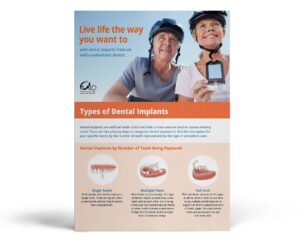Types of Implants & Techniques
Types of implants
There are two main types of implants:
Endosteal
These dental implants are placed in the jawbone. Typically made of titanium and shaped like small screws, they are the most commonly used type of implant.
Subperiosteal
These dental implants are placed under the gum but on, or above, the jawbone. This type of implant may be used in patients who do not have enough healthy natural jawbone and cannot, or do not want to, undergo a bone augmentation procedure to rebuild it.
Alternative Dental Implant Techniques
Depending on the health of your jawbone and your specific needs, your dental implant dentist may suggest some alternative treatment options in addition to the traditional multi-step dental implant procedure. Options may include:
If your jawbone is not able to support dental implants, several techniques can be used to rebuild bone, restore your natural jawline and provide a sturdy foundation for implant-supported teeth. These include:
Bone augmentation
This involves restoring or regenerating bone in your jaw when it is not able to support implants otherwise. Research shows that using bone additives and growth factors to fortify the bone generally achieves the best results.
Sinus lift
Also called sinus augmentation or sinus elevation, this involves adding bone below the sinus in cases where natural bone has deteriorated due to missing upper back teeth.
Ridge expansion
If your jaw isn’t wide enough to support dental implants, bone graft material can be added to a small ridge, or space, created along the top of your jaw.
3D Imaging and Treatment Planning
State-of-the-art, highly precise 3D digital imaging and implant surgical planning software have made implant procedures faster and highly predictable. Your dentist can use these tools to analyze the anatomy of your jaw and determine the best sites for implant placement before surgery. This saves time and money, and shortens recovery time.
Immediate Load Dental Implants
Also called same day implants or Teeth in a Day®, immediate load dental implants allow placement of a temporary tooth during the same appointment as your dental implant placement. This may be a good option if you have enough natural bone and an implant secure enough to support immediate placement and pressure on the new temporary tooth.
Mini Dental Implants (MDIs)
Also called small or narrow diameter implants, these toothpick-sized implants are narrower than most commonly used dental implants. They are placed through less-invasive techniques and are used primarily to stabilize a lower denture.
All-on-4®
All-on-4 is an alternative to placing a top or bottom set of replacement teeth, called a full arch. Four dental implants are placed in available bone, avoiding the need for bone grafting. Special abutments are used so that a temporary set of replacement teeth can be placed the same day. You follow a modified diet while the gum tissues heal and the implants bond with your natural bone. After about six months, the permanent replacement teeth will be placed and you can resume a regular diet.
How do I care for my dental implants?
Well-placed and cared for dental implants have the potential to last a lifetime. Caring for teeth restored with dental implants is just like caring for your natural teeth: brush, floss and get regular dental cleanings and check-ups. Dental-wise: FAQsWant to learn more about types of dental implants?
Download our educational brochure here!
 Download Brochure
Download Brochure
American Academy of Implant Dentistry
Copyright ©2022 American Academy of Implant Dentistry



